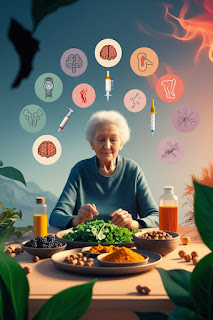Exploring How High Sugar Intake Reduces the Effectiveness of Herbs and Antioxidants
By Brian S.
Learn how sugar interferes with the absorption and bioactivity of herbal antioxidants. Discover the science behind this effect and how to optimize herbal therapy by limiting sugar intake.
Visual contrast of antioxidant-rich fruits, turmeric, and herbs on one side, and refined sugar cubes on the other, symbolizing how sugar inhibits antioxidant absorption in the gut
Herbal medicine has long been celebrated for its antioxidant, anti-inflammatory, and restorative properties. However, few realize that a high-sugar diet may directly compromise the effectiveness of these remedies. Modern research now reveals that sugar doesn’t just add calories—it interferes with the very mechanisms that allow herbs to function in the body.
The Overlooked Problem: Sugar and Herbal Absorption
Many herbal antioxidants—like quercetin, catechins, curcumin, and resveratrol—are reliant on specific transporters and metabolic pathways to be absorbed and activated. Yet, refined sugar (glucose, fructose, and sucrose) can inhibit or overload these systems, ultimately reducing the bioavailability of these plant compounds.
1. Transporter Competition: Sugar Blocks Phytochemical Absorption
Plant-based antioxidants like quercetin and green tea catechins use specific transporters in the intestines, such as SGLT1, GLUT2, and OATP1A2. These same transporters also handle glucose. When sugar is present in high amounts, these transporters are saturated, reducing the body's ability to absorb herbs consumed at the same time (Youdim et al., 2003; Cermak et al., 2004).
2. Advanced Glycation End Products (AGEs): Antioxidant Neutralizers
High sugar levels promote non-enzymatic glycation reactions, leading to the formation of advanced glycation end products (AGEs). These AGEs:
- Inactivate dietary antioxidants, preventing them from neutralizing free radicals.
- Inhibit key antioxidant enzymes, such as superoxide dismutase and glutathione peroxidase (Brownlee, 2001).
This means sugar doesn't just compete with herbs—it actively destroys their antioxidant potential.
3. Sugar Increases Oxidative Stress
Ironically, sugar—while suppressing antioxidant absorption—also amplifies oxidative stress. Chronic intake leads to:
- Increased mitochondrial ROS (reactive oxygen species).
- Activation of NADPH oxidase, producing more free radicals (Urakawa et al., 2003).
Herbal antioxidants are often insufficient to balance this pro-oxidant burden when sugar intake remains high.
4. Gut Microbiota Disruption: A Hidden Blockade
The gut microbiome plays a critical role in converting certain polyphenols and tannins into bioactive forms. However, sugar promotes dysbiosis, including overgrowth of Firmicutes and loss of beneficial Bacteroidetes. This alters the metabolism of:
- Ellagitannins from pomegranate and berries (reduced urolithin production).
- Isoflavones and lignans from soy and flax.
This impairs the systemic availability of these plant-derived metabolites (Selma et al., 2009).
5. Inflammatory Signaling: Blocking the Antioxidant Response
A high sugar diet activates inflammatory cascades:
- Increased NF-κB and mTOR signaling.
- Reduced expression of NRF2, the master switch for antioxidant response genes (Kawabata et al., 2010).
Thus, sugar not only blocks antioxidant absorption—it prevents the body from even responding to them properly.
Implications for Herbal Practitioners and Health Enthusiasts
For those relying on herbal medicine for preventive care, detoxification, or chronic disease management, sugar may be a silent saboteur. Consider the following practices:
- Avoid sweetened herbal preparations (e.g., syrup-based tonics, rock sugar).
- Use water or unsweetened tinctures as delivery mediums.
- Encourage low-glycemic diets to complement herbal regimens.
- Educate patients on the antagonistic role of sugar in natural healing.
Conclusion
The relationship between sugar and herbal bioactivity is no longer anecdotal—it's backed by a growing body of biochemical and clinical evidence. To maximize the benefits of herbs and antioxidants, reducing sugar intake is not optional—it’s essential. In the age of functional foods and natural medicine, awareness of this interaction may define the success or failure of a wellness plan.
References
Brownlee, M., 2001. 'Biochemistry and molecular cell biology of diabetic complications.' Nature, 414(6865), pp.813–820.
Cermak, R., Landgraf, S. and Wolffram, S., 2004. 'Quercetin glucosides inhibit glucose uptake into brush-border-membrane vesicles of porcine jejunum.' British Journal of Nutrition, 91(6), pp.849–855.
Kawabata, K., Mukai, R. and Ishisaka, A., 2010. 'Quercetin and related polyphenols: new insights and implications for their potential health benefits.' Current Opinion in Biotechnology, 21(2), pp.279–281.
Selma, M.V., Espín, J.C. and Tomás-Barberán, F.A., 2009. 'Interaction between phenolics and gut microbiota: role in human health.' Journal of Agricultural and Food Chemistry, 57(15), pp.6485–6501.
Urakawa, H. et al., 2003. 'Oxidative stress is associated with adiposity and insulin resistance in men.' The Journal of Clinical Endocrinology & Metabol'ism, 88(10), pp.4673–4676.
Youdim, K.A. et al., 2003. 'Interaction between flavonoids and the blood-brain barrier: in vitro studies.' NeuroReport, 14(1), pp.39–45.
Copyright © 2025 www.zentnutri.blogspot.com. All Rights Reserved.











